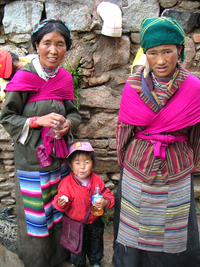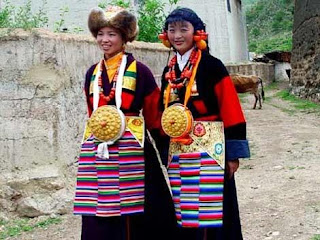Pretty much the majiority of the garments in Dries Van Notens' S/S 2011 collection sums up the kind of menswear i would be interested in making. Ive always had a little fascination with tipping a bottle of bleach over some fabric. I love his unusual shapes and mixed use of colour. Its clear he is keen to experiment and push boundaries which is how i feel i could work. After seeing this collection im keen to look more into the use of natural dyes and inks to create more than just a surface pattern, but a unique statement.
Sustainable Menswear
Sunday, January 8, 2012
Thursday, January 5, 2012
Traditional Tibetan Clothing
Whilst looking at sustainability in fashion I have begun to look at fashion in other cultures or communities that is conciered sustainable.
Here i have been looking at the stunning Tibetan fashion. I personally love the use of colour and detail. I love all the layers, lots of beads and fabric easpecially.
Here i have been looking at the stunning Tibetan fashion. I personally love the use of colour and detail. I love all the layers, lots of beads and fabric easpecially.
Clothing:
Tibetan clothing has a strong connection with the people, and climate of "Roof of the world". The Tibetan's clothing reflects the history, beliefs, and character of the local people.
Tibetan clothing has a strong connection with the people, and climate of "Roof of the world". The Tibetan's clothing reflects the history, beliefs, and character of the local people.
Each area of Tibet has its own distinct style of clothing. The clothes are influenced by the religion, and environment. Tibetan clothing consists of a robe and shirt. The Tibetan robe worn by men is broad and is normally fastened under the right arm, while the women's are slightly narrower with or without sleeves. The robes often fastened with two cloth belts. The shirts are also fastened on the right. Men typically wear white shirts with high collars, while women wear various colors with turndown collars.
In northern Tibet, were the weather is bitterly cold, herdsmen wear a fur lined robe years round. Their robe also doubles as their quilt at night. Since the day and night temperatures vary greatly, during the day they usually do not put their arms in their sleeves, but rather tie the sleeves around their waste wearing their robe as a kind of skirt. Their fur lined robes are very bulky and have no pockets, but being fastened at the waist it gives the wearer plenty of room inside for to carry daily necessities, or even their children inside.
In pastoral areas the clothing worn by herdsmen are distinctive for their decorations. Their clothing is usually hemmed in black cloth at the front and lower edges and cuffs. Women wear aprons decorated with colorful cloth stripes.
In the south of Tibet where the weather is warm and damp, the clothing is made from hand woven woolen cloth. Both men and women button their clothing on the right. Men's clothing are hemmed in colorful cloth, or with silk, while women normally wearing sleeveless robes.
In Lhasa, where the weather is warmer and damper many men wear double layered robes, and women dress in close-fitting robes and long sleeved shirts, with brightly decorated aprons. The apron is one of Tibetan women's favorite clothing articles. According to custom the aprons are only worn by married women. It is a privilege that young girls look forward to.
Tuesday, January 3, 2012
Re-worked Trashion
One idea that I get from sustainability is that its not just eco friendly materials, you can use materials of any kind, eco or not and make them sustainable by upcycling them into something else, or simply giving them a bit of re-vamp!
These jackets are a beautiful example of re-working something old
Mottainai
"The word Mottainai (moe tie nie) roughly translates into "what a waste", and can be interpreted to sum up when people squander natural resources. Deeply embedded in Japanese folk tales, it is commonly used by parents to ensure children eat all of their rice. Children are taught that if they waste things, the "mottainai ghost" will come.
The Mottainai brand was created in 2007, in Brooklyn, NY out of a collective disappointment in the abundance of substandard clothing. Most clothes seemed needless and others incomplete. We set off to design collections based on necessity and frame of mind. Mottainai garments are for those who understand the importance of environmental stewardship and whose modern lifestyle demands innovative creations. Authentic, simple, and resourceful"
Functional
The Mottainai brand was created in 2007, in Brooklyn, NY out of a collective disappointment in the abundance of substandard clothing. Most clothes seemed needless and others incomplete. We set off to design collections based on necessity and frame of mind. Mottainai garments are for those who understand the importance of environmental stewardship and whose modern lifestyle demands innovative creations. Authentic, simple, and resourceful"
Fall 2010 collection.
Functional
Spring 2010 Collection
Subscribe to:
Comments (Atom)
















































